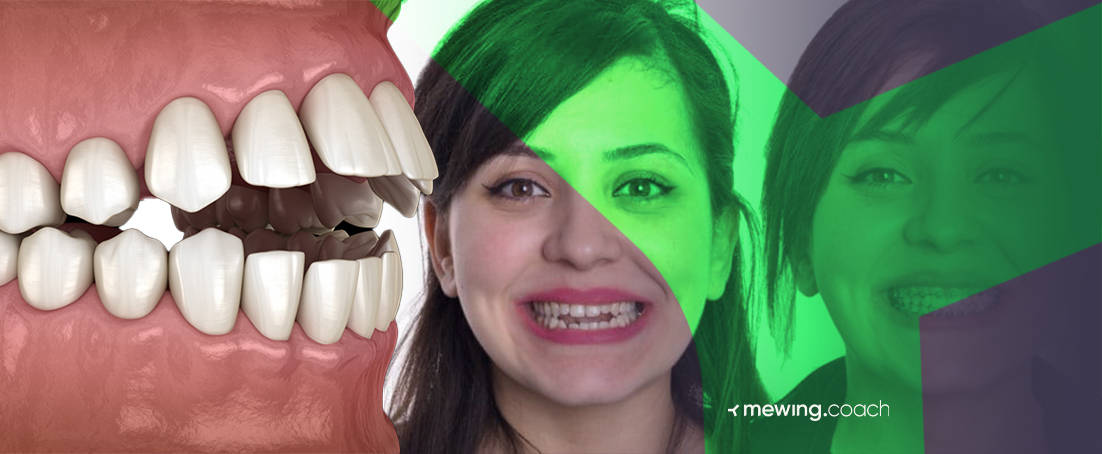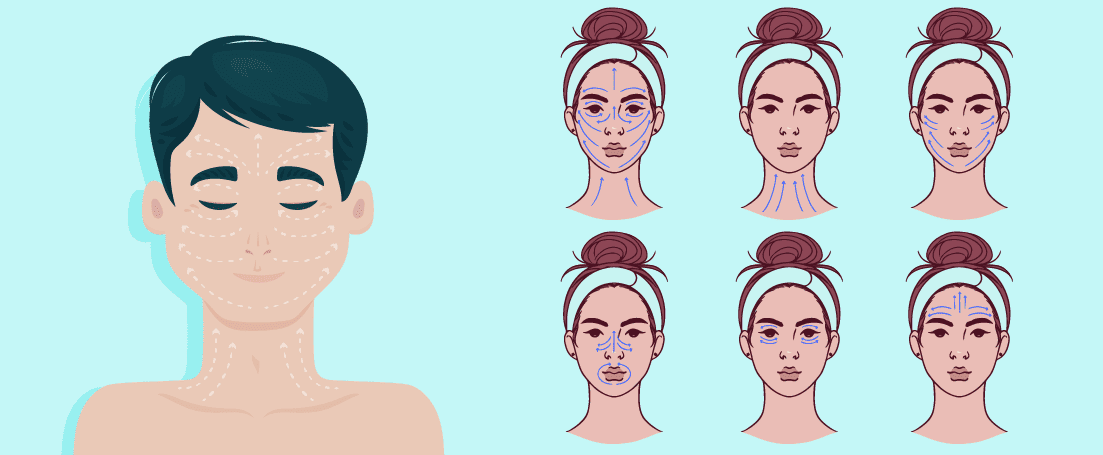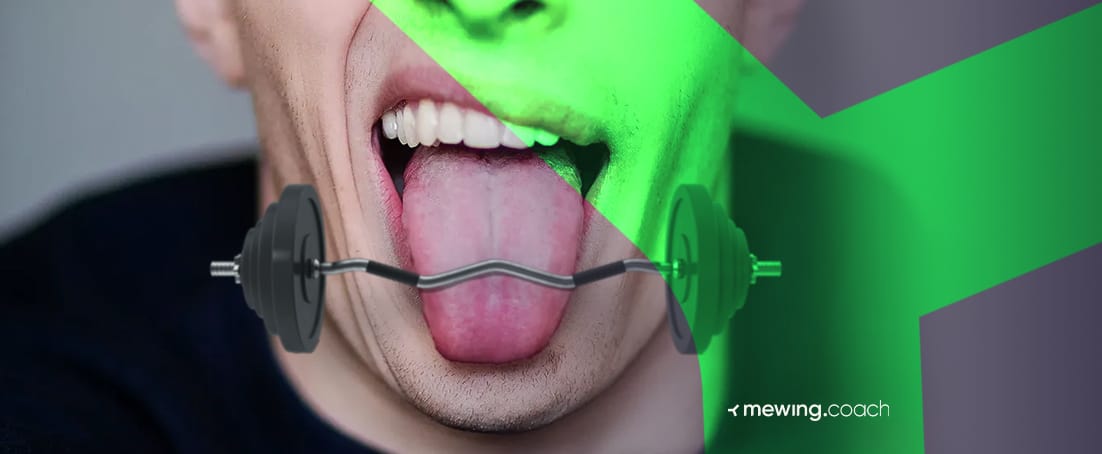Having an open bite is one of the most problematic dental issues a person can have. Not only are you left with misaligned teeth, but you also have issues with eating. Luckily there are ways to fix it naturally. Repeating facial exercises and proper tongue posture are some of the simple ways you can use to reduce or prevent an open bite.
Seeking additional info on open bites? You can find it in the article below. But before that, here’s what else you’ll learn:
- 📖 What is an open bite?
- 😷 What are the causes of open bites?
- 👄 How can mewing help fix an open bite?

What Is an Open Bite?
An open bite results when the top and lower teeth are misaligned. You can notice it when you close your mouth, and the top and bottom teeth don’t come together.
Besides causing jawline asymmetry, an open bite leads to overlapping of the teeth. This phenomenon is what gives the teeth an “open” appearance. An open bite is noticeable even when the mouth is closed because the teeth look slanted forwards – this is one of the few facial features that are not attractive, but luckily, it can be solved.
Although an open bite is a type of malocclusion of the teeth, the issue itself is quite rare. Only 0.6% of people in the US have been reported to suffer from an open bite. This can be because of misdiagnoses or the ease with which an open bite is treated. An open bite generally occurs due to genetic and skeletal issues or poor oral habits.
There are several classifications we can make regarding open bites. Below we outline the most common ones.
Anterior Open Bite vs. Posterior Open Bite
Open bites appear either in the front teeth or back teeth. When the open bite occupies the frontal teeth area, it is an anterior open bite. In this case, the upper and lower teeth are not touching when the mouth is closed. This is because the front teeth are creased outwards. The anterior open bite is the most common open bite condition.
On the other hand, if the open bite is on the back teeth, then it is referred to as a posterior open bite. It is determined when several teeth reach contact but do not make full occlusion.
If you need a trick to differentiate them, just remember that anterior refers to the upper teeth, while posterior refers to the lower back teeth.
Dental Open Bite vs. Skeletal Open Bite
An open bite can be classified as either dental or skeletal. A skeletal open bite occurs as a result of a poor upper and lower jaw skeletal relationship. Skeletal bites usually happen due to genetics. These bites occur if the lower and upper jaws grow apart instead of parallel to each other. This type of open bite shows vertical disharmony between the upper and lower jaws.
If your open bite is on the back teeth, then it most likely is a dental open bite. This type of open bite is recognizable in the fact that it is surrounded by soft and hard tissues. A dental open bite appears due to poor oral habits like prolonged use of pacifiers, thumb sucking, tongue thrusting, etc.
The main difference between a dental open bite and a skeletal one is the fact that a skeletal open bite appears on a cephalometric radiograph as a defect, while a dental open bite does not.
Open Bite Causes
There are numerous causes for an open bite and even more resulting problems. In the text below, we’ll give you the most common causes of an open bite.
Genetics
If your family has had issues with teeth alignment, there is a great chance that you will inherit it too. Skeletal open bites are one example; these can result in needing jaw surgery.
Habits
Bad oral habits such as thumb sucking can result in a dental open bite. Sucking on a finger or a foreign object causes strain on the teeth and prevents their alignment. This leads to biting problems that end up with eating issues.
Misaligned Jaw
A misaligned jaw appears due to misaligned teeth and is often genetic. Unparalleled teeth cause not equal biting. The upper jaw bites in a further position than the lower, which inhibits the ability to chew food properly.
Orthodontic Treatment Complications
If you have had issues in the past with your baby teeth, there is a great chance you will encounter issues with your adult teeth. Wearing braces in your childhood could result in sore and sensitive gums, which hinders alignment.
Tooth Extraction or Loss
Teeth misalignment can appear due to early teeth extraction. If you have lost your baby teeth earlier than usual, your adult teeth might take a longer time to develop. But, if you lose your baby teeth later, it could result in crooked adult teeth. Crooked teeth lead to an open bite.
Trauma to the Face and Jaw
Trauma to the face and jaw can result in lost teeth. Losing your permanent teeth can lead to bite problems, difficulty chewing, and an open bite.
Bruxism (Grinding or Clenching of Teeth)
If you unknowingly clench or grind your teeth during the day or during your sleep you may develop bruxism. The main cause of this condition is stress. Sometimes bruxism can be treated with proper jaw and tongue alignment. Specialists recommend treating bruxism with mewing and avoiding stress.
Chronic Mouth Breathing
By keeping your mouth open most of the time, you strain your jaw. This usually happens when you’re sleeping and can lead to the jaw becoming misaligned with time. Learning the breathing through the nose vs. mouth difference can help treat open bite symptoms in these cases.
Neuromuscular Disorders Such as TMJ Dysfunction
This type of dysfunction happens due to jaw muscle and ligament inflammation. TMJ conditions may become chronic, and the resulting pain is either mild or severe. The TMJ disorder and mewing go hand in hand because proper jaw and tongue exercises can prevent it.
Aging and Changes in the Shape of the Face and Jaw
Gaining and losing weight can result in an open bite in later years. Older age can weaken the strength of the jaw bones, and even skin sagging can affect the lower jaw.
Unbalanced Muscle Function in the Face and Jaw
Overusing your upper teeth can cause jaw misalignment. This also refers to chewing on one side.
Certain Medical Conditions Affecting Jaw Growth and Development
This includes soft tissue dysfunction, prognathism, certain syndromes, microdontia, etc. Suffering from any of these conditions makes you a candidate for an open bite.
15 Ways to Fix Open Bite Naturally
Having an open bite does not mean it’s the end of the world. There are a few ways to correct open-bite issues, and we give you the top ones right below.
1. Speech Therapy
The first natural way to combat open bite is by going to therapy. A speech therapist will assess the issue and train you in proper tongue placement. They can give you exercises for your tongue, which will improve jaw alignment. A speech therapist will also advise against negative oral habits.
2. Orthotropics
Another sure open bite fix is through orthotropic. Consulting an orthotropic specialist will allow you to get customized exercises that will improve facial development. An orthotropic practitioner can also evaluate your breathing habits and show you a way to optimize airway development.
3. Bite Correction Exercises
You can treat an open bite with bite correction exercises too. This involves gentle chewing and biting movements that will improve your jaw alignment. Other exercises are the isometric ones that strengthen the jaw muscles. You can also include tongue and lip workouts that better oral posture.
4. Massage and Stretching

Massaging and stretching the jaw muscles will improve mobility and relieve pain. You can also use heat or cold therapy to reduce painful spots and swelling. This also helps with easing stress.
5. Acupuncture
Acupuncture is the best choice if you are suffering from chronic jaw pain and tension. The licensed acupuncturist will target specific points to prevent an open bite.
6. Chiropractic Treatment Method
Talking to an experienced chiropractor can help you with jaw development. They perform gentle manipulations of the jaw and neck to improve alignment and can also relieve pain by massaging and stretching the jaw muscles.
7. Dental Splint Therapy for Misaligned Teeth
Dental splint therapy is recommended if you decide to talk to a dentist. A dentist can recommend a custom-fit splint or bite guard. The bite guard will ease the biting pressure and correct an open bite.
8. Tongue Exercises such as Tongue Thrusting to Improve Oral Posture

Properly aligning your tongue can prevent an open bite. It can also reduce pain and tension. The exercises will help you maintain correct oral posture, even when swallowing or speaking. Tongue exercises go well with relaxation techniques to alleviate the jaw.
9. Jaw Muscle-Strengthening Exercises
Jaw muscle-strengthening exercises are isometric workouts that improve alignment. Their job is to improve stability and eliminate pain. Stretching the area afterward is recommended.
Mewing: Nearly Perfect Method to Treat Open Bite Without Surgery
All of the above methods are incorporated in one simple technique – mewing. This is the process of learning proper tongue placement. The mewing benefits are countless – not only do you get the correct teeth position when mewing, but you can also mew to reduce the crossbite.
If you want a comprehensive mewing presentation, you can check out our Mewing.Coach app. Here you will learn everything you need to know about what is the correct tongue position for mewing and why mewing is an effective way to treat overbite and other biting issues.
Simply visit our app and get your personalized plan!
If you want to know more about the advantages of mewing, check out the results below.
Open Bite Before and After Mewing Results
If you take a look at the before and after mewing results, you will see the fascinating mewing effect on severe underbite.
You will also see that this technique can create stunningly toned faces that put models to shame. High cheekbones and perky lips are just around the corner if you practice mewing right away!
Other Popular Open Bite Treatment Options
Besides the previously mentioned ones, here are 6 other treatments that can help treat open bites:
10. Braces

The best way to treat misaligned teeth is with braces. Moreover, you can mew with braces and double the effect.
11. Veneers
Replacing your teeth with veneers might be the priciest option, but it is recommended when you encounter severe touch decay.
12. Invisalign Clear Aligners
Invisalign is an alternative teeth-straightening treatment that is transparent. Unlike braces, they are not visible. Moreover, you can mew with Invisalign too.
13. Tooth Extraction
Due to improper teeth alignment, some teeth might rot sooner than others. Tooth extraction is the solution if you have severe tooth decay or gum disease.
14. Replacement of Missing Teeth
Teeth replacement is recommended if there’s an issue of overcrowded teeth.
15. Jaw Surgery
Surgery is the last resort if the open bite is extremely severe.
How To Prevent Open Bite and Avoid the Relapse
To prevent an open bite or avoid getting it back, make sure to:
- Monitor your oral habit. This means proper dental hygiene.
- If you have trouble with teeth grinding, wear a mouth guard in your sleep.
- Plan regular dental check-ups to follow the condition.
- Address any sleep disorders to avoid potential issues like bruxism.
When To Seek Professional Help?
You should consult a specialist if you notice the following:
- When noninvasive treatments are ineffective. If you notice that massages and exercises don’t reduce the pain, book an appointment with a dental practitioner.
- If jaw pain or discomfort persists, no matter the therapy or cause.
- For severe misalignment of the jaw that may be caused due to various reasons, like trauma to the face or genetics.
- For orthodontic treatment planning and advice. Don’t do things on your hand; always consult a professional.
Takeaway
If you notice an open bite forming, there is no need to go under the knife – try fixing it with natural remedies. Make sure to go to speech therapy, visit a chiropractor, massage the area, and do jaw and tongue exercises like mewing.
You can check out our Mewing.Coach app. After a few sessions of mewing, you will be in less pain and happier with what you see in the mirror!




